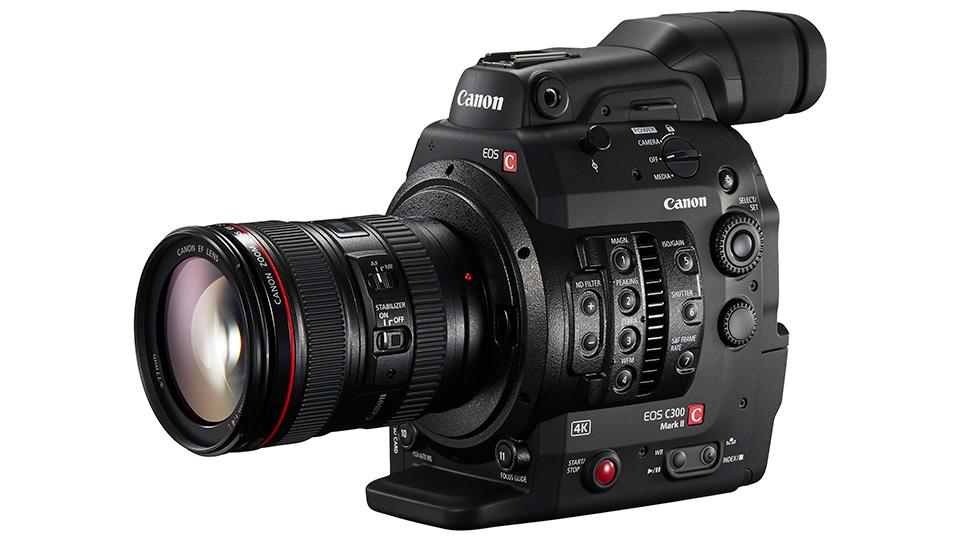With NAB 2015 just around the corner, Canon has decided to kick the party off early by announcing two new 4K cameras: the Canon EOS C300 Mark II and the compact fixed-lens XC10. As the successor to the wildly popular EOS C300, the C300 Mark II sees several major improvements that raise it to the level of, or even surpassing, the C500. This includes internal 4K and UHD recording to CFast cards, 4K RAW output, and an OLED electronic viewfinder. These upgrades, among others, could help make the C300 Mark II even more ubiquitous on video productions than its esteemed predecessor. At the opposite end of the spectrum, the XC10 is a compact camcorder with a DSLR-esque shape, 1″ CMOS sensor, and fixed 10x zoom lens. The camcorder aims at the prosumer-level market, being versatile enough to handle a wide range of applications from event work to use with handheld motorized gimbals or drones.
Canon EOS C300 Mark II
The EOS C300 Mark II takes the baton from the original C300 and keeps running. What will excite the most people will be internal 4K recording at either true DCI 4K (4096 x 2160) or Ultra HD (3840 x 2160) resolution, to appease both broadcast and cinematic shooters. The 4K CMOS sensor is equivalent in size to Super 35mm, and is driven by dual DIGIC DV 5 image processors. The camera is available in Canon EF or PL mount versions, depending on your lens preference. The benefit of the EF-mount version is that you can take advantage of Canon¡¯s Dual Pixel CMOS AF technology, which supports a variety of autofocus modes, including continuous AF and Face Recognition when used with compatible Canon EF lenses. The camera also sees a boost in its ISO range, now boasting a range of 160 to 25600 ISO (100 to 102400 ISO when sensitivity is expanded).
Rather than the dual Compact Flash card slots found on the original C300, the Mark II records to newer and faster CFast cards, which provide the speed required to handle high-bit-rate 4K recording. Video files still use MPEG-4 AVC/H.264 compression and the MXF file format, but you can now enjoy Intra frame 4K recording at up to 410 Mb/s. You can also enjoy Intra frame recording at 2K/1080p resolutions, as well as the broadcast-friendly LongGOP 50 Mb/s format. Lower bit-rate proxy files can be recorded to SD cards. Accompanying these internal recording options is the ability to output 4K raw video, a feature previously found only on Canon¡¯s C500 Cinema EOS camera.
Physically speaking, the C300 Mark II does see some changes. While the EVF is now slightly smaller, at 0.46″ (compared to 0.52¡± on the original C300), it now features a new OLED screen that should deliver rich blacks and accurate colors. The angle of the EVF is adjustable up and down 60 degrees and has a +2 to -5.5 adjustable diopter range to accommodate vision correction for most shooters. There has also been a slight tweaking of the button layout, with the most obvious being a large red Start/Stop button being placed low on the left side (operator¡¯s side) of the camera, in a convenient position to press with your left hand.
Canon XC10 4K Camcorder
?
The XC10 is a unique camera that could easily find a home in the gear bags of consumers and professionals alike. Its body design, in many ways, is a hybrid between a DSLR, a palm-sized camcorder, and a Cinema EOS camera, equipped with a built-in 10x lens, flip-out 3.0″ LCD touchscreen, and a 90-degree rotatable handgrip. The system is built around a 1″ 4K CMOS sensor¡ªwhich is quite large for a fixed-lens camera¡ªand a DIGIC DV 4 processor that deliver 8-bit 422 video at resolutions up to Ultra HD at 24 and 30 fps (305 Mb/s). It can also capture 1080p video at 60 fps, 50 Mb/s, and 30/24 fps at 35 Mb/s.
On top of 4K video, the camera can also take 12-megapixel photos (4:3) and features common still-camera exposure modes, including Auto, program AE, shutter priority, aperture priority, and¡ªof course¡ªmanual exposure. It is even possible to capture photos while simultaneously recording or playing back video. In these cases, the image size will be the same as the video resolution, so if you¡¯re shooting UHD video, you can grab 8.29-megapixel images. 4K video is recorded to a CFast memory card, while HD video and photos are recorded to SD cards.
The built-in 10x Canon zoom lens is optimized for 4K video and provides a 35mm equivalent focal range of 27.3 to 273mm in video mode (24.1 to 241mm in 4:3 photo mode). It has a maximum aperture of f/2.8 at the wide end of the range and f/5.6 at the telephoto end. To help you capture smooth-looking handheld footage, the lens has built-in optical and digital image stabilization. Manual focus and zoom rings allow you to operate it just as you would any DSLR lens.
The XC10 offers a variety of picture profiles to select from, including the standard options you¡¯ll find in the Cinema EOS line, such as Wide DR and even Canon Log. This makes the camcorder a great ¡°B¡± camera for owners of Cinema EOS cameras, as you should be able to match the looks seamlessly. Of course, the camera is also a more-than-capable ¡°A¡± camera for a variety of applications, such as documentary or live event work. It could also be an ideal pairing with handheld motorized gimbals or mounting on drones.
Connections on the XC10 include a hot shoe, HDMI output, USB port, microphone input, and a headphone jack. In terms of power, the camera uses the same LP-E6-type batteries common to Canon DSLRs like the 5D Mark II and 7D Mark II. When long continuous recording is needed, a DC power input powers the camera from an external. Other features include built-in dual band (5 GHz / 2.4 GHz) Wi-Fi and GPS support via the optional GP-E2 adapter.


